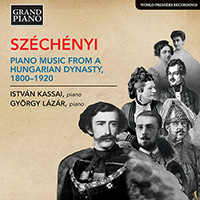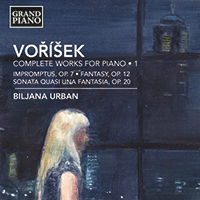
About this Release
“I was introduced to the music of Sándor Balassa when I was 12 years old. Years later, the 81-year-old composer kindly put his trust in me and asked me to record all of his piano works. I found a surprising and pleasant diversity in them, more than I had expected, which made me want to play the music even more. Balassa’s lyrical compositional style and his sophisticated application of tone and timbre lends a unique style to all his works. I heartily recommend these works for everyone to listen to or play, as I am certain that everyone will find in them as much pleasure as I did when I was learning them!” — István Kassai
BALASSA, SÁNDOR (1935–2021)
Complete Piano Music • 1
- István Kassai, piano
Distinguished Hungarian composer Sándor Balassa’s philosophy on his music is that it ‘has to be whole, beautiful, interesting and appealing; as natural as if it were this way since the beginning of time, and so that anyone can pick it up with a feeling of joy.’ Balassa’s uniquely sophisticated textures, timbres and lyrical style can be heard here in pieces for young pianists, remarkable works originally written for cimbalom, and in the Baroque references and sweeping momentum of the Szonatina No. 1.
This recording was made on a modern instrument: Steinway, Model D
Tracklist
|
5 Testvér (5 Brothers), Op. 5 (1960) (00:09:00 )
|
|
1
No. 1. Moderato, poco espressivo (00:01:40)
|
|
2
No. 2. Allegretto movimento (00:00:43)
|
|
3
No. 3. Sostenuto, pesante (00:00:53)
|
|
4
No. 4. Allegro ma non troppo (00:01:26)
|
|
5
No. 5. Andante cantabile (00:03:45)
|
|
Levelek a rezervátumból (Letters from the Reservation), Op. 87 (version for piano) (2004) (00:12:00 )
|
|
6
No. 1. Moderato (00:00:44)
|
|
7
No. 2. Allegretto (00:01:26)
|
|
8
No. 3. Vivo (00:01:31)
|
|
9
No. 4. Andante (00:02:20)
|
|
10
No. 5. Movimento con moto (00:01:03)
|
|
11
No. 6. Cantabile tranquillo (00:02:46)
|
|
12
No. 7. Presto (00:02:13)
|
|
2 Zongoradarab (2 Piano Pieces), Op. 137 (2014) (00:07:00 )
|
|
13
No. 1. Adagio - Allegretto - Adagio (00:03:53)
|
|
14
No. 2. Allegro ma non troppo (00:02:46)
|
|
Ládafia, Vol. 1 (From an Old Chest, Vol. 1), Op. 113 (2009) (00:14:00 )
|
|
15
No. 1. Pasztorál (Pastorale) (00:00:48)
|
|
16
No. 2. Allegretto (00:00:34)
|
|
17
No. 3. Üzenet (Message) (00:00:50)
|
|
18
No. 4. Etűd (Etude) (00:00:41)
|
|
19
No. 5. Horizont (Horizon) (00:01:03)
|
|
20
No. 6. Dallam (Melody) (00:00:52)
|
|
21
No. 7. Legato (00:02:01)
|
|
22
No. 8. Kürtök és trombiták (Horns and Trumpets) (00:01:08)
|
|
23
No. 9. Különös arc (A Peculiar Face) (00:00:55)
|
|
24
No. 10. Nyári könnyu szello (Light Summer Breeze) (00:00:32)
|
|
25
No. 11. Allegro (00:01:12)
|
|
26
No. 12. Szelíden és vadul (Gently and Fiercely) (00:01:40)
|
|
27
No. 13. Egyszerű ének (Simple Song) (00:01:03)
|
|
28
No. 14. Fürge játék (Fast Game) (00:01:14)
|
|
Ládafia, Vol. 2 (From an Old Chest, Vol. 2), Op. 120 (2010) (00:21:00 )
|
|
29
No. 1. Prelúdium (Prelude) (00:01:49)
|
|
30
No. 2. Kicsi (Little) (00:00:32)
|
|
31
No. 3. Dombról jövet (Coming Down the Hill) (00:02:07)
|
|
32
No. 4. Capriccio (00:01:07)
|
|
33
No. 5. Borsószem (A Pea) (00:01:08)
|
|
34
No. 6. Elutasított kérés (Request Denied) (00:02:01)
|
|
35
No. 7. Csőlátó (Tunnel Vision) (00:00:59)
|
|
36
No. 8. Barlangban (In a Cave) (00:01:30)
|
|
37
No. 9. Ugróiskola (Hopscotch) (00:01:06)
|
|
38
No. 10. Kápolna (Chapel) (00:01:04)
|
|
39
No. 11. Tánczene (Dance Music) (00:01:37)
|
|
40
No. 12. Furcsa pár (Strange Couple) (00:00:46)
|
|
41
No. 13. Titkos kert (Secret Garden) (00:02:47)
|
|
42
No. 14. Posztludium (Postlude) (00:01:51)
|
|
Piano Sonatina No. 1, Op. 23, No. 5 (1961) (00:10:00 )
|
|
43
I. Andantino (00:02:14)
|
|
44
II. Marciale, con movimento (00:01:37)
|
|
45
III. Tranquillo cantabile (00:01:57)
|
|
46
IV. Veloce (00:03:27)
|
The Artist(s)
 Kassai has won several first prizes in international competitions such as the International Piano Competition for Young Artists in 1972 in Czechoslovakia, the Piano Competition organised by Hungarian Radio in 1979, and the Paris International Debussy Piano Competition in 1982. Moreover, Kassai’s artistic talent was acknowledged by such prestigious awards as the ARTISJUS-Prize in 1976, the Bonnaud-Chevillion-Prize of the Fondation de France in 1986, the Nívó Prize of Hungarian Radio in 1990, the Ferenc Liszt Prize in 2001 and the Leó Weiner Memorial Prize in 2010. He has been a full member of the Hungarian Academy of Art since 2013.
Kassai has won several first prizes in international competitions such as the International Piano Competition for Young Artists in 1972 in Czechoslovakia, the Piano Competition organised by Hungarian Radio in 1979, and the Paris International Debussy Piano Competition in 1982. Moreover, Kassai’s artistic talent was acknowledged by such prestigious awards as the ARTISJUS-Prize in 1976, the Bonnaud-Chevillion-Prize of the Fondation de France in 1986, the Nívó Prize of Hungarian Radio in 1990, the Ferenc Liszt Prize in 2001 and the Leó Weiner Memorial Prize in 2010. He has been a full member of the Hungarian Academy of Art since 2013. 







 Grand Piano has gained a reputation for producing high quality recordings of rare keyboard gems. Dedicated to the exploration of undiscovered piano repertoire, the label specialises in complete cycles of piano works by many lesser-known composers, whose output might otherwise have remained unknown and unrecorded.
Grand Piano has gained a reputation for producing high quality recordings of rare keyboard gems. Dedicated to the exploration of undiscovered piano repertoire, the label specialises in complete cycles of piano works by many lesser-known composers, whose output might otherwise have remained unknown and unrecorded.






